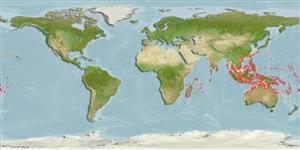Actinopterygii (ray-finned fishes) >
Perciformes (Perch-likes) >
Caesionidae (Fusiliers) > Caesioninae
Etymology: Caesio: Latin, caesius, bluish-grey, 1835; it is the same name given to the silvery metal (Cs) (Ref. 45335). More on author: Seale.
Environment / Climate / Range
Ecology
Marine; reef-associated; non-migratory; depth range 5 - 50 m (Ref. 30874). Tropical, preferred ?; 30°N - 34°S, 28°E - 157°W (Ref. 402)
Indo-West Pacific: East Africa to the Line Islands. Not occurring in the Red Sea or the Arabian (Persian) Gulf.
Size / Weight / Age
Maturity: Lm ? range ? - ? cm
Max length : 40.0 cm TL male/unsexed; (Ref. 11228); common length : 26.6 cm SL male/unsexed; (Ref. 37816)
Dorsal
spines
(total): 10;
Dorsal
soft rays
(total): 14-16;
Anal
spines: 3;
Anal
soft rays: 12 - 13. Tail fin and peduncle, and body above a diagonal from just anterior to origin of dorsal fin to ventral origin of caudal peduncle bright yellow (except in large ones in western Pacific, yellow does not extend as far as anteriorly); rest of upper 2/3 of body bright blue; lower third silvery white. Indonesian populations have yellow from origin of dorsal and most of the back to below lateral line over the posterior part and tail (Ref. 48635). 4-5 scales on cheek; 20-28 predorsal scales; scaled dorsal and anal fins; Supra-temporal band of scales interrupted at dorsal midline by a scaleless zone. Upper peduncular scale rows 11-13; lower peduncular scale rows usually 15 or 16 (14-17). A small process on each ventrolateral surface of basioccipital for attachment of Baudelot's ligament (Ref. 1723). Head length 2.6-3.6 in SL; body depth 2.7-4.2 in SL (Ref. 90102).
Found primarily around coral reefs, with a preference for coralline lagoons. Feeds on zooplankton in large midwater groups. Forms schools with other caesionids. Migrates to select areas around the reef to spawn near the surface in the entrances of deep channels during outgoing tides on a lunar cycle. Oviparous, with numerous, small pelagic eggs (Ref. 402). Also caught with drive-in nets.
Life cycle and mating behavior
Maturity | Reproduction | Spawning | Eggs | Fecundity | Larvae
Mass spawning of this species observed to occur only around sunset at or near full moon.
Carpenter, K.E., 1987. Revision of the Indo-Pacific fish family Caesionidae (Lutjanoidea), with descriptions of five new species. Indo-Pac. Fish. (15):56 p. (Ref. 1723)
IUCN Red List Status (Ref. 115185)
CITES (Ref. 94142)
Not Evaluated
Threat to humans
Harmless
Human uses
Fisheries: minor commercial
More information
ReferencesAquacultureAquaculture profileStrainsGeneticsAllele frequenciesHeritabilityDiseasesProcessingMass conversion
Tools
Special reports
Download XML
Internet sources
